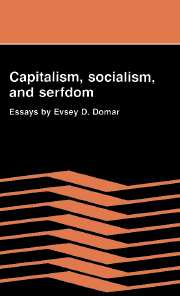Book contents
- Frontmatter
- Contents
- List of tables and figures
- Foreword
- Acknowledgments
- Part I Economic systems
- Part II Economic growth and productivity
- Part III Soviet economics
- Part IV Slavery and serfdom
- 12 The causes of slavery or serfdom: a hypothesis
- 13 On the profitability of Russian serfdom
- 14 Were Russian serfs overcharged for their land by the 1861 Emancipation? The history of one historical table
- Index
13 - On the profitability of Russian serfdom
Published online by Cambridge University Press: 05 March 2012
- Frontmatter
- Contents
- List of tables and figures
- Foreword
- Acknowledgments
- Part I Economic systems
- Part II Economic growth and productivity
- Part III Soviet economics
- Part IV Slavery and serfdom
- 12 The causes of slavery or serfdom: a hypothesis
- 13 On the profitability of Russian serfdom
- 14 Were Russian serfs overcharged for their land by the 1861 Emancipation? The history of one historical table
- Index
Summary
Introduction
Why did the Russian government emancipate the serfs in 1861? Of the several explanations offered – fear of a serf revolt (Gerschenkron), raisons d'état (Blum), cultural factors (Field), military needs (Rieber), the general crisis of serfdom (several Marxist historians) – the hypothesis most enticing to an economist was suggested by the Soviet historian M. N. Pokrovskii: the serfs were freed because serfdom had become unprofitable for the masters. It is enticing because profitability is quantifiable. In contrast to other explanations, this hypothesis can be subjected to a theoretical analysis and, with luck, to an empirical test. This is the purpose of this essay.
Pokrovskii attributed the alleged fall in the profitability of Russian serfdom to the rise in grain prices following the repeal of the British Corn Laws. To our surprise, this rather implausible explanation made more sense than one would expect: the effect on serfdom of a rise in grain prices, a more or less accidental event, will be shown to be similar to the effects produced by population growth, a much more important phenomenon. Both of these effects are analyzed in the first of our four models. Being free of specifically Russian conditions, the model may be widely applicable. Our next two models, in contrast, deal with two conditions particular to the Russian case: a limit on the serfs' labor obligations (called here “Paul's Law”) and the specific rates of exchange between the serfs' land allotments and their labor obligations (the “Inventories”) imposed by the government in several Western provinces.
- Type
- Chapter
- Information
- Capitalism, Socialism, and SerfdomEssays by Evsey D. Domar, pp. 239 - 279Publisher: Cambridge University PressPrint publication year: 1989

